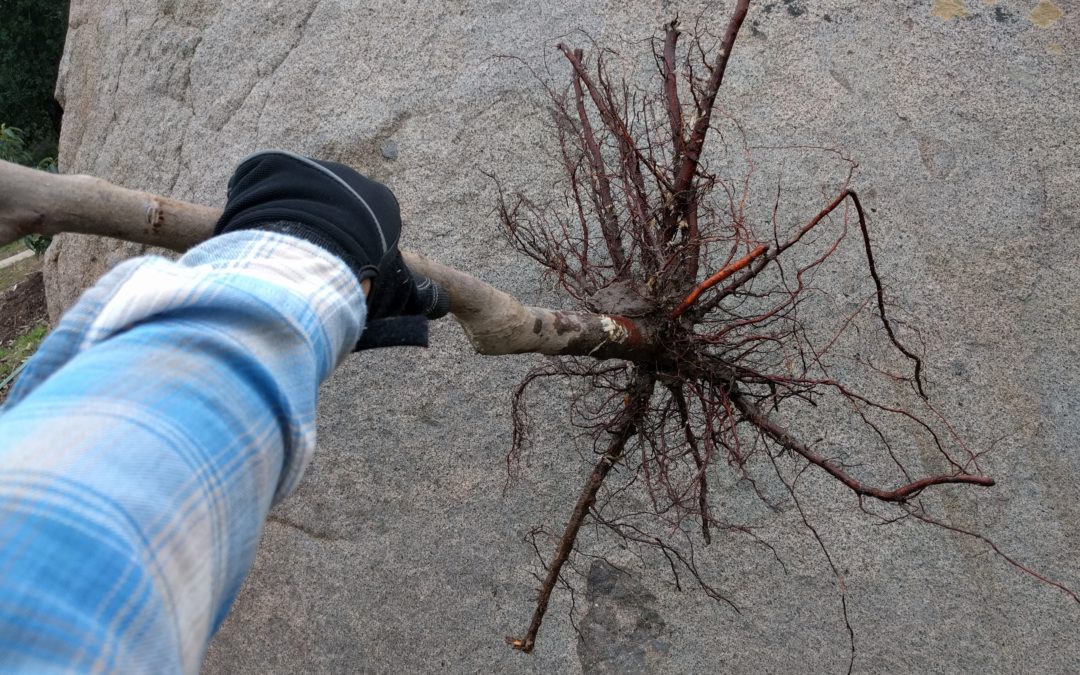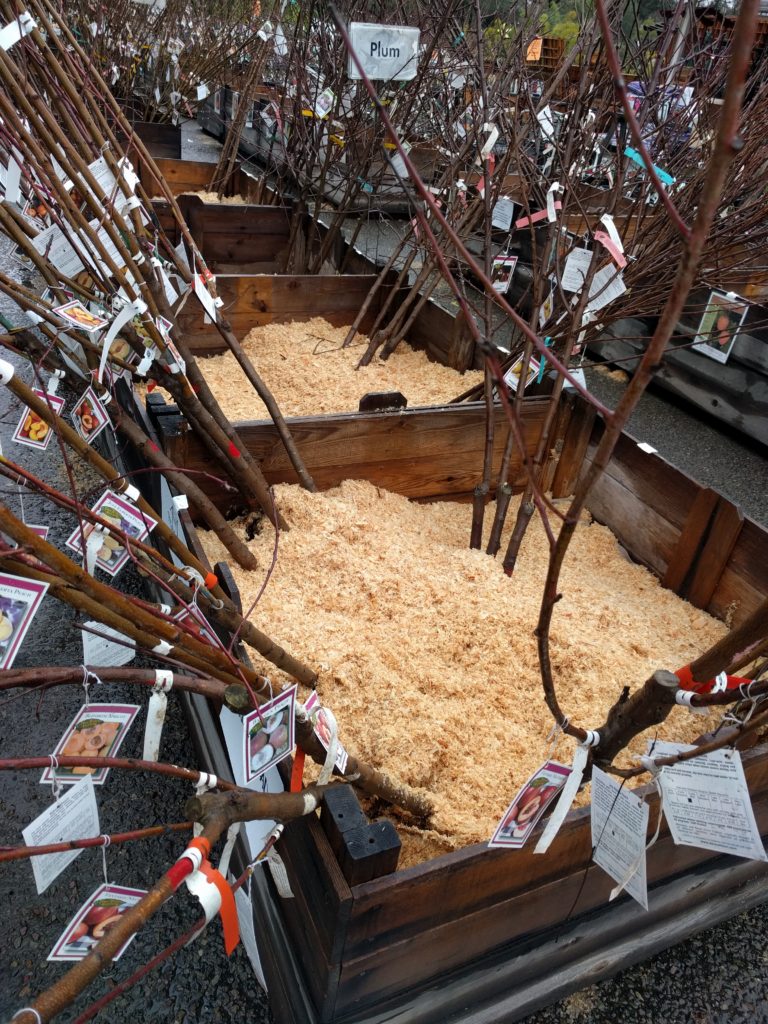It’s as though there’s a second Christmas for food gardeners because around this time nurseries receive shipments of bare root fruit trees (as do mail order suppliers like Peaceful Valley). What’s so exciting about bare root fruit trees? And what are they anyway?
Wholesale growers of deciduous fruit trees (apricots, apples, peaches, plums, pomegranates, etc.) dig up their young trees as soon as they’ve lost their leaves and entered dormancy in the late fall, shake the soil off their roots, and ship them to retail nurseries. (Watch a fascinating video of the process at Dave Wilson Nursery’s growing grounds in Central California.) Good retail nurseries then display the “bare” root trees in bins of moist wood shavings or something similar rather than sticking them into soil in pots.
Bare root trees are healthier
This has many advantages for us, the home gardeners. First, we get a more wholesome, healthy tree. In order to stick a tree into soil in a pot, nurseries have to cut off a significant amount of a tree’s root system to make it fit. Bare root trees can be left with much larger root systems. The more roots, the stronger the tree.
Cheaper
Second, soil and pots are costs for the nursery. In turn, the nursery charges more for a potted tree than a bare root tree. The same nectarine tree in a pot might cost us $35 instead of $30 or less bare root.
Offer more varieties
Selection is also better during bare root season. Now is when nurseries will have their greatest array of species and varieties on hand. You might find ten different plum varieties to choose from now whereas there will only be three to choose from in the spring (in pots). What happens is that once the bare root trees start waking from dormancy and flowering and growing leaves, the nurseries have to get those leftover trees into pots so their roots can begin supplying the tops of the trees with water and nutrients. (Don’t stress: trees should be available bare root at Southern California nurseries from now through the month of January and into February, depending on the weather.)
Easy to plant
One of my favorite things about buying a bare root tree is how easy it is to plant. It’s even easier to haul home from the nursery in the first place since it’s so much lighter without a pot full of soil to drag along. Once you have the hole for the tree dug, all you do is plop the tree down, spread out its roots and cover them with dirt — you don’t have to cut off a plastic container or yank the roots out of it. Planting a potted tree is so unwieldy in comparison, even if you really know what you’re doing. (Here’s a video from Peaceful Valley showing how to plant a bare root tree.)
Additionally, it’s so easy to care for a newly planted bare root tree since you’re by definition planting it while the weather is mild in December or January, and when there’s rain falling on occasion. After planting and watering in a bare root tree you can almost forget about it until the spring. Transplanting a tree is hard on it, but doing so while it’s “sleeping” and while the weather is gentle makes the process less shocking. Such a good start to life in a new place goes a long way.
Get a bigger, unpruned tree
In the end though, it’s all about the health and productivity of the tree you buy, and on average the bare root fruit trees I’ve planted over the years have outperformed the potted trees I’ve planted. It’s certainly due in part to them having larger root systems to begin with. It’s also partly due to the fact that you can get a tree that hasn’t been “topped” already. Nurseries often cut the tops off trees when they put them in pots.
If the nursery offers to cut the top off your bare root tree, say no thanks. Don Shor of Redwood Barn Nursery explains why in this article. “The more leaves you have, the faster the roots will grow,” is the summary. I also relate my experiences with pruning or not pruning bare root trees in my post, “Should you prune a bare-root fruit tree?”
Unsure of which kind of bare-root fruit tree to choose this winter? See my post, “What kind of fruit tree should you plant?”
Unsure of which spot in the yard to plant a fruit tree? Read my post for some guidance on that here.
All of my Yard Posts are listed HERE





Happy Holidays Greg. I so love your posts. In a few months I want to buy an avocado tree to grow in a pot. I want a tree that will produce, not just decoration. Do you have any suggestions? I live in Castaic, the tree will be outside all year.
Hi Cynthia,
I can only give advice on this tentatively; I’ve never grown an avocado in a pot long term. Based on those I’ve seen others grow to fruiting, I’d choose a variety that is precocious and not too vigorous. Pinkerton, Lamb, GEM, Carmen, and Hass come to mind.
In the past I’ve noticed that bare root trees arrive at the nurseries in the beginning of January therefore I start calling the nurseries at the end of December to nail down the first day they arrive. Here is why. Suppose you want a Red Baron peach tree and suppose the nursery receives 8 bare root trees on January 5th and put them for sale starting on the 6th. If you get there on the 6th there are probably 8 Red Baron trees to pick from. The trunk diameters will range from about 1″ to .5″. You will get to pick the largest and best formed tree of the bunch. So, the best of the bunch will be sold until the worst trees are left. I was surprised to find that Evergreen and Kniffings were not selling bare root, but were only selling them planted. After some thought I realized why. They plant the larger trunk trees in 15 gallon pots and the smaller diameter trees in 5 gallon pots. That is why I went to Walter Andersen downtown on the first day the bare roots were available. I bought a Cotton Candy Aprium, 4 in 1 Pluot, and a Red Baron Peach that would have cost me double as 15 gallon at the other nurseries.
Hi Richard,
Early bird gets the worm! I think you’re mostly right about that. On the other hand, I’ve noticed that some people buying bare-root fruit trees aren’t sure how to choose the best of the bunch. Do you want lots of roots, the thickest trunk, the most side branches, the tallest, the straightest, one that’s already showing some flowers? It might be partly because of that that some very good trees will still be left in the bins at the end of the season.
So sad that so many nurseries just pot up all the bare-root trees they receive these days, meaning they must cut off plenty of healthy roots in order to fit them into the containers, not to mention the added expense, weight, and difficulty in planting for us. I understand that from their perspective it’s difficult to create space and all the bins to hold the bare roots, plus to care for them. But in my experience as a consumer, bare-root fruit trees have always grown better than potted trees. We ought to show and tell those nurseries like Walter Andersen’s who still sell bare roots that we appreciate it.
Hi just got my first grafted apple bear rooted tree in New Zealand wots best way to plant and take care off